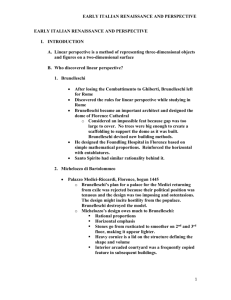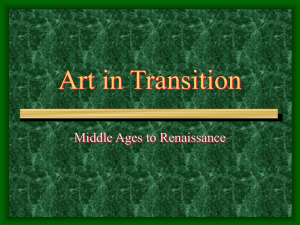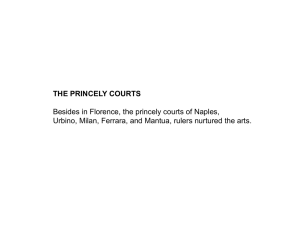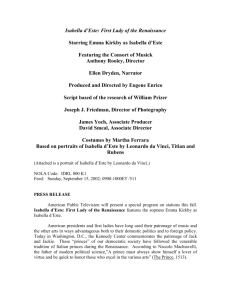Document 10467175
advertisement
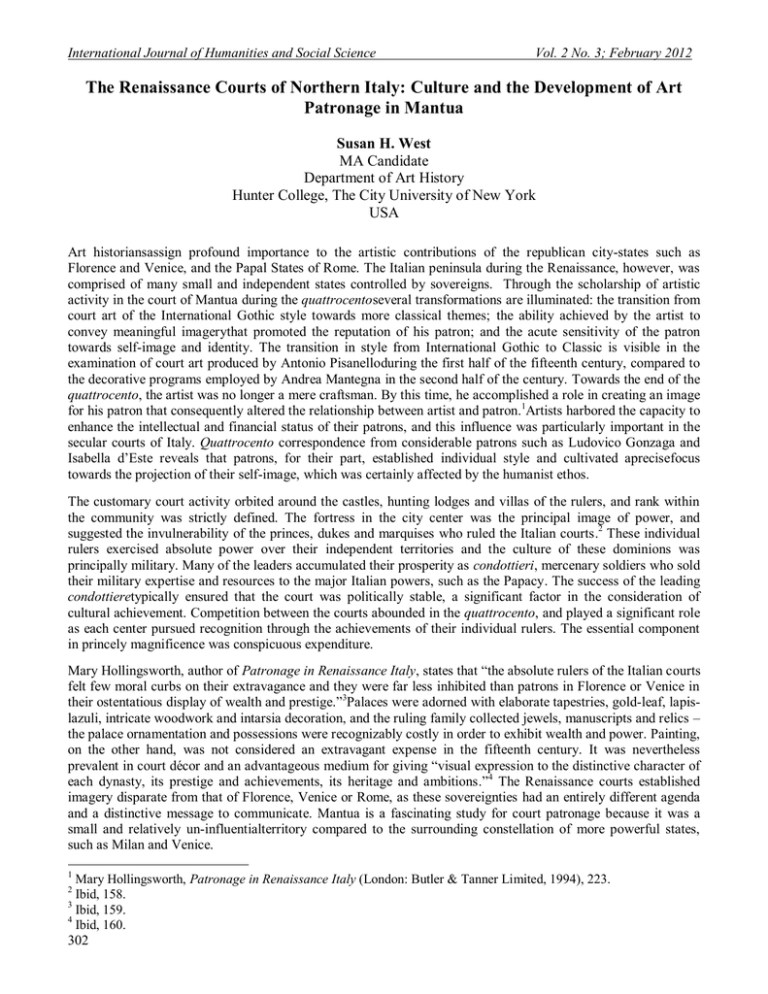
International Journal of Humanities and Social Science Vol. 2 No. 3; February 2012 The Renaissance Courts of Northern Italy: Culture and the Development of Art Patronage in Mantua Susan H. West MA Candidate Department of Art History Hunter College, The City University of New York USA Art historiansassign profound importance to the artistic contributions of the republican city-states such as Florence and Venice, and the Papal States of Rome. The Italian peninsula during the Renaissance, however, was comprised of many small and independent states controlled by sovereigns. Through the scholarship of artistic activity in the court of Mantua during the quattrocentoseveral transformations are illuminated: the transition from court art of the International Gothic style towards more classical themes; the ability achieved by the artist to convey meaningful imagerythat promoted the reputation of his patron; and the acute sensitivity of the patron towards self-image and identity. The transition in style from International Gothic to Classic is visible in the examination of court art produced by Antonio Pisanelloduring the first half of the fifteenth century, compared to the decorative programs employed by Andrea Mantegna in the second half of the century. Towards the end of the quattrocento, the artist was no longer a mere craftsman. By this time, he accomplished a role in creating an image for his patron that consequently altered the relationship between artist and patron.1Artists harbored the capacity to enhance the intellectual and financial status of their patrons, and this influence was particularly important in the secular courts of Italy. Quattrocento correspondence from considerable patrons such as Ludovico Gonzaga and Isabella d’Este reveals that patrons, for their part, established individual style and cultivated aprecisefocus towards the projection of their self-image, which was certainly affected by the humanist ethos. The customary court activity orbited around the castles, hunting lodges and villas of the rulers, and rank within the community was strictly defined. The fortress in the city center was the principal image of power, and suggested the invulnerability of the princes, dukes and marquises who ruled the Italian courts.2 These individual rulers exercised absolute power over their independent territories and the culture of these dominions was principally military. Many of the leaders accumulated their prosperity as condottieri, mercenary soldiers who sold their military expertise and resources to the major Italian powers, such as the Papacy. The success of the leading condottieretypically ensured that the court was politically stable, a significant factor in the consideration of cultural achievement. Competition between the courts abounded in the quattrocento, and played a significant role as each center pursued recognition through the achievements of their individual rulers. The essential component in princely magnificence was conspicuous expenditure. Mary Hollingsworth, author of Patronage in Renaissance Italy, states that “the absolute rulers of the Italian courts felt few moral curbs on their extravagance and they were far less inhibited than patrons in Florence or Venice in their ostentatious display of wealth and prestige.”3Palaces were adorned with elaborate tapestries, gold-leaf, lapislazuli, intricate woodwork and intarsia decoration, and the ruling family collected jewels, manuscripts and relics – the palace ornamentation and possessions were recognizably costly in order to exhibit wealth and power. Painting, on the other hand, was not considered an extravagant expense in the fifteenth century. It was nevertheless prevalent in court décor and an advantageous medium for giving “visual expression to the distinctive character of each dynasty, its prestige and achievements, its heritage and ambitions.”4 The Renaissance courts established imagery disparate from that of Florence, Venice or Rome, as these sovereignties had an entirely different agenda and a distinctive message to communicate. Mantua is a fascinating study for court patronage because it was a small and relatively un-influentialterritory compared to the surrounding constellation of more powerful states, such as Milan and Venice. 1 Mary Hollingsworth, Patronage in Renaissance Italy (London: Butler & Tanner Limited, 1994), 223. Ibid, 158. 3 Ibid, 159. 4 Ibid, 160. 302 2 © Centre for Promoting Ideas, USA www.ijhssnet.com The small sovereignty not only emerged from the turbulent episodes of the quattrocento intact, but also with an establishedreputation as a leading cultural center on the Italian peninsula. Molly Bourne, an art historian and specialistin Gonzaga court circa 1500, suggests that the stability and success of the duchy were “the result of a tripartite strategy employed by its ruling family, the Gonzaga, which integrated dynastic allegiance, diplomacy, and artistic patronage.”5The city maintained two prestigious historical claims: it was the birthplace of the Roman poet Virgil and the custodian of the significant relic of the Blood of Christ, held in the ancient Benedictine abbey of the Sant’ Andrea which was originally built in the ninth century. Mantua was located on the Po River plain, and was geographically protected by water on three sides. With a population of approximately 25,000, it was similar in size to nearby Ferrara and significantly smaller than Milan. Bourne has suggested that the powerful neighboring states of Venice and Milan served as buffers that supported Mantua’s autonomy within Italy’s fragile balance of command. The imagery produced in this small statetherefore had to excel in its purpose as propaganda to “advertise its status in competition with Italy’s leading rulers.”6The court was among the first to acquire an official resident artist, and British art historian Kenneth Clarkdetermined that Mantua was indeed an exemplarymodel for the European ruler until the time of Versailles. The Gonzagas of Mantua, descendents of a local land owning family, established control of the city in 1328 and maintained their sovereignty until 1627. Ludovico II Gonzaga (1444-1478), recognized as one of the most prominent patrons of the fifteenth century, initiated the urban renewal campaigns that transformed Mantua into one of the most illustrious centers of the Renaissance.Ludovico’s father, Gianfrancesco (1395-1444), was appointed Marquis of Mantua by the Holy Roman Emperor in 1433, an investiture that established political links between Mantua and the Empire and marked a critical turning point for the prestige of both the Gonzaga family and the city.7Ludovico further secured this network with his marriage to Barbara of Brandenburg. Both Ludovico and his German wife were educated in the rigorous curriculum at Vittorino da Feltre’s school, where they were trained in history, oratory, poetry, ethics, astronomy, mathematics, music, and the martial arts. Ludovico, arguably the most conscious observer of humanistic values of the Gonzaga rulers, was appointed the second Marquis of Mantua upon the death of his father in 1444.8 During the second half of the fifteenth century, Ludovico’s initiatives as patron vastly improved the exterior of Mantua. In 1459 Ludovico exploited his marital and political connections to the German imperial court in an effort to persuade Pope Pius II to hold his forthcoming Congress on the crusade against the Turks in Mantua. The nine month residency of the papal court, and the attention that ensued,prompted Ludovico to commission significant restorations and repairs within the center of Mantua and in many of the family’s provincial domains. In addition to extensive renovations to the Palazzo Ducale, Ludovico redecorated many of the Gonzaga castles and hunting lodges outside of the city in Cavriana, Goito, Gonzaga, Marmirolo, San Martino di Gusnago and Saviola. These renovations allowed Ludovico to host guests in handsome accommodations in hopes that the luxury and modernization of Mantua would penetrate the social networks of communication among the secular courts of Renaissance Italy, as this would leverage Ludovico’s reputation. Among the most important projects of his renovatio urbis was thecommission for the new church of San Sebastiano (1460) and the reconstruction of Sant’ Andrea (1470), both of which were built according to the designs of the leading Florentine architect Leon Battista Alberti.9The Sant’Andreaas aforementioned possessed a famous relic of the Blood of Christ thatattracted pilgrimages from afar, which generated substantial repute and income. According to legend the sacra pisside, a pyx containing a few drops from the Blood of Christ, was carried in to Mantua in 37 AD by the Roman centurion Longinus.10The architectural commissions completed under Ludovico’s command exhibit a radical change of imagery to promote his prestige and to support his broader political strategy. Alberti was the finest choice for promoting visual expression to the grand, classically inspired image that Ludovico sought to project in his reconstruction efforts. 5 Molly Bourne, “The Art of Diplomacy: Mantua and the Gonzaga 1328-1630,” in The Court Cities of Northern Italy, ed. Charles M. Rosenberg (New York: Cambridge University Press, 2010), 138. 6 Hollingsworth, Patronage in Renaissance Italy, 213. 7 Ibid, 211. 8 Bourne, “Art of Diplomacy,” 152. 9 Hollingsworth, Patronage in Renaissance Italy, 212. 10 Bourne, “Art of Diplomacy,” 146. 303 International Journal of Humanities and Social Science Vol. 2 No. 3; February 2012 A major aesthetic shift occurred mid-century to the interior rooms of the palace that distinguished Mantua by replacing the courtly Gothic and chivalric themes for the language of ancient Rome, and this conversion established a manifest association with an imperial power.11 Before investigating the mid-century artistic shift in Mantua, it is important to consider the common chivalric themes of courtly art, popularized by the castles of northern Europe and often termed the International Gothic style, which traditionally ornamented the Italian palaces. Ludovico would have associated his youth and early reign in the Gonzaga palace with images of gallantry, knights in armor and romanticized tales.In the first half of the century, Antonio Pisanello operated frequently in the court of Mantua. Pisanello, an artist who was praised by his contemporary poets and humanists, served the Gonzaga court for increments of time during the 1420s and again in the 1440s. He was quite influential and the room referred to as “Sala del Pisanello,” even during the fifteenth century, is a rare example of work named after the artist rather than its decorative subject.12The walls from the Sala del Pisanelloare covered in sinopieunder-drawings and fresco that illustratesscenes of knights participating in jousting tournaments [Figure 1]. The imagery was discovered after the removal of whitewash in 1966-1972, and serves as an excellent example of the motifs that frequently adorned courts in northern Italy during the quattrocento. Bourne asserts that modern scholars “have recognized the subject of Pisanello’s unfinished cycle in Mantua as one of the thirteenth-century Arthurian legends: the story of Bohort, cousin of the legendary Lancelot, jousting to win the hand of an admiring princess amidst Gonzaga banners and horse caparisoned in the family colors of red, white, and green.”13The Pisanello frescoes are in a deteriorated state, yet the style is still identifiable. Evidence of elaborate detail is still apparent, the knights in armor evoke a costume effect, and the crowded compositions are all elements of the International Gothic style. A noble joust was a suitable theme for the family of condotierri, and the dark background along with the heraldic frieze makes the fresco appear similar to a richly-ornamented tapestry. The Gonzagas werecertainly inspired by chivalric imagery from the courts of northern Europe, who relied upon this style to communicate political messages. Some sources assign the patronage of this room to Ludovico while others attribute the room to his father, Gianfrancesco, who inherited a vast library collection filled with French literature from his father. The SaladelPisanelloindicatesthe foundation of an essentialmessage in the court of Mantua: the identity of the Gonzaga as both men of arms and men of letters, a theme that would be advanced by Ludovicoin the following decades.14 Ludovico’s patronage exhibits a fusion of the intellectual and princely self as originally set forth through the craftsmanship of Pisanello. It is difficult to trace sources and the movement of ideas in Renaissance art, but it seems plausible that Ludovico was the first ruler to hire an artist to work almost exclusively for his court and reside in his palace.15Ludovico’s desire to promote the Gonzaga name and trump his competitionaccelerated his efforts to entice Andrea Mantegna from Padua to become his resident court painter.16Though it was early in his career, Mantegna at this time had already demonstrated financial stability as an independent painter and, in response to Paduan humanist patrons, developed a splendidall’antica style “with figures derived from antique reliefs and settings that revived the architectural language of ancient Rome.”17The surviving correspondence reflects the fact that Mantegna was not immediately persuaded to assume the position of resident court painter, though the terms offered were certainly generous. In a passage from a letter marked April 15 th 1458, Ludovico wrote: “…so that you may know at once our good will towards you we advise you that our own intention is to reserve for you in good faith everything which we have promised you in our letter at other times, and still more; that is to say, 15 ducats a month, the provision of rooms where you can live with your family, enough food each year to feed six, and enough firewood for your use. 11 Hollingsworth, Patronage in Renaissance Italy, 213. Bourne, “Art of Diplomacy,” 151-152. 13 Ibid. 14 Ibid. 15 Kenneth Clark, The Art of Humanism (London: Jolly & Barber Ltd, 1983), 123. 16 D.S. Chambers, Patrons and Artists in the Italian Renaissance (Columbia: University of South Carolina Press, 1971), 58. 17 Hollingsworth, Patronage in Renaissance Italy, 213. 304 12 © Centre for Promoting Ideas, USA www.ijhssnet.com Do not have the slightest doubt about all this; and so that you may not incur any expense in bringing your family here, we are happy to promise that at the time you want to come we shall send down a small ship at our expense to move you and your household and bring you here so that it will not cost you anything. And because Maestro Luca tells us you would dearly like to wait another six months in order to finish the work for the Reverend protonotary of Verona and dispatch the rest of your business, we are very content, and if these six months are not enough for you, take seven or eight, so that you can finish everything you have begun and come here with your mind at rest…” Mantua, 15 April 1458.18 Ludovico’s courtship of Mantegna continuedwith the reassurance that the Gonzagas “by the grace of God have never yet broken a promise”, and that if the terms wereinadequate Ludovico would “seek in every way to satisfy” Mantegna’s requirements. Mantegna’s work was incongruent with the International Gothic style of northern Europe, which corresponded with Ludovico’s strategy to advance his court by breaking away from conventional gestures of chivalry. Mantegna’s interest in the classical period also synchronized with Ludovico’s humanist education. Hollingsworth confirms the ruler’s concentration: “instead of the ideal of knightly chivalry, Ludovico commissioned Mantegna to paint a cycle of frescos that gave visual expression to the prestige of the Mantuan court and stressed its association with the imperial traditions of ancient Rome, not the courts of northern Europe.”19Mantegna’s early works captured his affinity for antiquarianism which he conveyed through Roman grandeur and austere discipline, the basis of Roman ethics. Stylistically he was drawn to the monumental tradition of Masaccio and infused his images with intriguing psychological depth, evidence of his inherent interest inboth naturalism and humanist virtues. After unremitting solicitations Ludovico persuaded Mantegna to accept the appointment as the resident artist to the court of Mantua in 1460. Mantegna was one of the leading artists of northern Italy and his activities in Mantua were incredibly varied. Clark asserts that Mantegna was the “arbiter of taste” who produced designs for architecture, sculpture, goldsmith work, tapestry, embroidery, scenery for Latin plays and that he even superintended pageants.20Prior to his employment in Mantua, Mantegna produced an assortment of commissions as an independent artist, including portraits, altarpieces, individual panels and fresco cycles. The diversity of his responsibilities invites conjecture as to whether or not Mantegna actually enjoyed his role in the court, and his service to the Gonzaga family. Perhaps Mantegna appreciated the privilege of participating in a wide-range of artistic activity; on the other hand, the role as artist factotum in an active court could have been rather oppressive. The court of Mantua during the latter half of the fifteenth century seems to have offered latitude in artistic expression and exploration, especially in comparison to the often analogous Church commissions that Mantegna would have accepted as an independent artist.While it is understandable that he was burdened by his miscellaneous duties, Mantegna did in fact endure as resident court artist for forty-six years – serving three generations of Gonzaga rulers and ultimately earning one of the finest reputations for an artist of his generation.21 Mantegna’s greatest fresco cycle was commissioned for the Camera Picta(“painted chamber”), also more recently termed the Camera degli Sposi (“bridal chamber”), of the Palazzo Ducale.The range of subject matter exemplifies Mantegna’s diversityin Mantua, and confirms the variety of artistic creativity that he was able to cultivate as resident artist. Mantegna worked on the Camera Picta from 1465 until 1474.The room required nine years of work, partially as a result of his preference for “tempering pigments with slow-drying oils instead of employing true fresco technique.”22The portraits throughout the room exhibit evidence that Mantegna harbored anexceptional sense of human relationships, and the extent to which the Gonzaga family portraits were recognizable must have been notable to contemporary viewers.23Mantegna’s decorative program in the Camera Pictadiverged considerably from Pisanello. The room presentsimages of Ludovico and his family in the privacy of their court, and reflects the interest in classical revival which was important to both patron and artist. 18 Chambers, Patrons and Artists in the Italian Renaissance, 117. Hollingsworth, Patronage in Renaissance Italy, 213-214. 20 Clark, The Art of Humanism, 123. 21 Bourne, “Art of Diplomacy,” 158. 22 Ibid. 23 Ibid, 159. 19 305 International Journal of Humanities and Social Science Vol. 2 No. 3; February 2012 The room is smaller than the vast Sala del Pisanello and the illustrations register a more intimate tribute to the Gonzaga court, as opposed to the gallant gestures and military insinuations in the earlier commission. Rather than a crowd of knights decorated in armor jousting activelywithin an unidentifiable space, the paintingsthroughout the Camera Pictaadvertisehonorable moments for the family that depict distinguishable portraits positioned within the palace and among contemporary associates.The Gonzagas are portrayed as noble, cultured, educated, and quite impressively as a family [Figure 2]. The painting displays the family members in the process of assembling for their portrait, and within this informal activity Mantegna is able to convey not only their images, but also more of the spirit within the family. Members are gathered for the portrait while projecting their role within the court family – Ludovico is conversing with an associate; his wife sitsresolutely beside him; the siblings are distracted and looking in various directions; and other members are ascending to the staging area. In the absence of chivalry, Mantegna was able to masterfully convey naturalism and essences of the human experience within the court of Mantua. The Camera Picta is a “tour-de-force” of Mantegna’s abilities as an illusionistic painter, and Bourne writes that the room is “transformed into an all’antica loggia in which the real architecture of the lunette vault is extended by a series of evenly spaced painted pilasters.”24Mantegna employed a sense of humor during this creation. The plump putti peer down through the illusionistic vault, some have their heads wedged between the crevices while others playfully extend a hand that holds an apple ready to drop into the chamber. This type of visual joke was typical of secular court humor, which found delight in playing tricks upon members of the upper class.25The humor and illusion augment thesense of creative spirit throughout the chamber, and alludes to Mantegna’s enjoyment of his professional appointment. Another indication that advocates Mantegna’s satisfaction with his position is the fact that he incorporated his own self-portrait, which is inventively hidden in the decorative foliage of a painted pilaster. The inclusion is a statement that documents his status as court artist of the Gonzaga family. When Ludovico died in 1478 he was succeeded by his eldest son, Federico I Gonzaga (1441-1484) who ruled for six years until his unexpected death in 1484 from a virulent fever. 26 Francesco II Gonzaga was only seventeen years old when he assumed control as the Marquis of Mantua in 1484 and ruled until his death in 1519. Francesco followed suit of his predecessors as arespectedcondotierre and his tenure as marquis was similar in length to his grandfather Ludovico, however his reputation as a patron of the arts was eclipsed by his legendary consort, Isabella d’Este, one of the first female collectors of the Renaissance period. The apartments of Isabella have helped scholars to define the understanding of female patronage and the representation of self-identity during the quattrocento.27This is not to suggest that Francesco did not contribute as a patron of the arts to the Mantua court. He is conventionally documented in history as a rather amusing and somewhat one-dimensional companion: a mercenary soldier preoccupied with breeding horses and hunting falcons.Bourne, however, has articulated in her contribution to the book titled Beyond Isabella that Francesco was in fact an active patron of the arts who commissioned works and participated in architectural projects for Gonzaga villas outside of the city, albeit much smaller in scale than the efforts of his grandfather. She suggests that by exploring the dynamic relationship between Francesco and Isabella as patrons, scholars are enabled “to locate their activities in a framework that studies how rulers and consorts employed art to negotiate the boundaries of gender and dynasty within the social circumscriptions of a Renaissance court.”28Isabella’s unique position as an “insatiable” female collector, the volume of her correspondence, and the audacious personality reflected within those letters, have leveraged the marchesa tothe forefront of art historical scholarship of patronage in Mantua. The unrelenting determination captured within her communication to artists and agents reveals the fact that, despite ardent pursuit and her distinction as the first female collector, Isabella was still confined to the private decoration of her own apartments in the Castello di San Giorgio. 24 Ibid. Ibid, 160. 26 Ibid, 161. 27 Molly Bourne, “Renaissance Husbands and Wives as Patrons of Art: The Camerini of Isabella d’Este and Francesco II Gonzaga,” in Beyond Isabella: Secular Women Patrons of Art in Renaissance Italy, ed. Sheryl E. Reiss et al. (Kirksville: Truman State University Press, 2001), 93. 28 Ibid, 95. 306 25 © Centre for Promoting Ideas, USA www.ijhssnet.com The camerini, or private apartments, of the secular courts were decorated to strategically convey the prestige and persona of its inhabitants to the guestswho were fortunate enough to be admitted. Members of the ruling family inherited the social obligation to display, and to exhibit the virtues of grandeur through conspicuous expenditure. Shortly after arriving to the court of Mantua in 1490, Isabella initiated her decorative campaign by dividing her collection into two specifically prepared rooms: thestudiolo and the grotta, a room directly below the study. The grotta was an intimate room that could comfortably accommodate about five people and was decorated with elaborate intarsia cabinetry for the storage of her antiquities collection. It was designed with a barrel-vaulted ceiling to improve acoustics for intimate concerts and literary discussion [Figure 3]. Collecting antiquities during the Renaissance was competitive and a predominantly male activity. Isabella’s involvement in the field was certainly innovative, and granted access to an unusually high profile which sanctioned her engagement in public forums that were traditionally inaccessible by court consorts.29 In the world of the Renaissance courts the studiolowas primarily a sanctuary that provided diversion and solace from public life. The origins of the studiolo promoted the vita contemplativaand Petrarch in his “De vita solitaria” wrote of the necessity for a room to establish closeness with God and to rejuvenate the jaded spirit.30 The fifteenth century witnessed the evolution of this “private” space, which was eventually used for professional transactions, diplomacy and sociability. Every item in this relatively small and ornamented room was therefore carefully selected to communicate a message regarding the inhabitant’s virtue, wealth, scholarship, heritage, military success, political interests, or beliefs. This calculated presentation related every object, book and painting in the room with its owner, and implied that a sophisticated foundation was required to comprehend the value and messages of these items. Stephen Campbell illuminates an interesting conflict regarding the collections in the studiolo by proposing that the room itself “represented an attempt to form the self through reading and the acquisition of appropriately “virtuous” objects, as well as to describe that self through these same objects.”31 The Renaissance studiolo operated within two different spheres of values – within the domain of the reader, the seeker of knowledge and self-development, and in the world of commodities and consumption. Isabella seems to have understood that a certain cultural capital depended upon her association with scholarship. In the surviving literature sheconveyed her desired intimacy of the studioloand grotta which harkens back to the original purpose of the room as set forth by Petrarch, an author with whom she would have immersed herself. She wrote to her friend the Duchess of Urbino: “The time that I thought to spend in joy and consolation with your ladyship, I shall now spend in solitude, remaining in my study.”32In 1491, shortly after arriving to the court of Mantua and when virtually all of her authority derived from the legal union with her husband’s family, Isabella instructed the painter Gianluca Leombeni to embellish the walls of her studiolo with a frieze of arms and symbols dominated by Gonzaga insignia.33 By 1496 the decoration of her studioloand grottatransitioned towards a more personalizedcampaign that included five large allegorical paintings. The allegorical subjects of the paintings were developed by the court literary advisor Paride da Ceresara, and seem to communicate a moralizing theme about female virtue. The evolution of individual aesthetic tastes was a result of living within the secular court, a life with an expectation to establish a reputation. Isabella was acutely aware of her public image, and like her grandfather in law Ludovico, projected her identity through patronage of the arts. The correspondence of Isabella d’Este relating to the arts has survived in greater abundance than that of any other single patron, and while the communication reveals a great deal about her character, it also occasionally sheds light upon the disposition of the artist that she was contracting. Isabella’s venture to acquire five paintings to decorate her study commenced in 1496, when she began to take initiative over the decorative program in her private apartments. Mantegna, resident painter for the past thirty-six years, provided the first two allegorical paintings, Parnassus and Allegory of Virtue. 29 Bourne, “Art of Diplomacy,” 166. Cecil H. Clough, “Art as Power in the Decoration of the Study of an Italian Renaissance Prince: The Case of Federico Da Montefeltro,” ArtibusetHistoriae(1995): 21. 31 Stephen Campbell, The Cabinet of Eros: Renaissance Mythological Painting and the Studiolo of Isabella d’Este (New Haven: Yale University Press, 2004), 41. 32 Ibid, 38. 33 Bourne, “Renaissance Husbands and Wives as Patrons of Art,” 97. 307 30 International Journal of Humanities and Social Science Vol. 2 No. 3; February 2012 The correspondence surrounding the acquisitions of the remaining paintings exposes Isabella’s concentration towards allegorical fantasy and pagan mythology as the theme in her study, and reveals her perseverance to commission the most distinguished artists such as Leonardo da Vinci, Giovanni Bellini, Giorgione and Raphael. Occasionally, the surviving correspondence illuminates the temperament of the artist, who achieved greater respect and professional rank by the end of the fifteenth century. The humanist advisor Pietro Bembo wrote a letter to Isabella concerning the acquisition of a painting by Giovanni Bellini that demonstrates stipulations set forth by the artist. In 1506, regarding Bellini, Petro Bembo wrote: “He does not like to be given many written details which cramp his style; his way of working, as he says, is always to wander at will in his pictures, so that they can give satisfaction to himself as well as to the beholder.”34 The correspondence indicates that Bellini was not only painting for the patron, he was painting for the “satisfaction to himself.” The freedom to “wander at will” on the canvas was a substantial condition achieved by the artist towards the end of the fifteenth century. The development of the Gonzaga art patronage in Mantua reveals the agendas and interests that were so prevalent in the secular courts of northern Italy. The patronage of Ludovico transformed the exterior and interior of the city center, as well as the provincial lodges of the Gonzaga territories. Ludovico’s personal development, which was certainly enriched by humanist educators, can be seen through the intimate decorative program in the Camera Picta, which evokes an entirely different and multi-dimensional message in comparison to the frescoes in the Sala del Pisanello. In addition, Alberti’s two Mantuan churches gave monumental visual expression to the classical message that Ludovico sought to project. 35While Ludovico was concerned with the overall communication of his court and the integrity of the Gonzaga dynasty, as a court consort Isabella’s patronage was tapered towards a more personal message. The correspondence of Isabella d’Este reveals a female account of a court patron’s resolve in establishing personal identity and promoting virtue, and this was united with the unwavering concentration to enhance the inner self. Court artists were vehicles of communication to articulate status and clout on behalf of the ruling family. There is an obvious divergence between the art created by Pisanello during the first half of the century which exhibits conventional courtly culture, and the naturalism that pervades the court art produced by Mantegna in the mid to late half of the century. The shift was stimulated by humanist values, the growing popularity of naturalism in imagery, and the freedom for artists to explore greater creative and psychological realms. Art generated by Mantegna in the court of Mantua demonstrates the creative latitude that an artist might have access to in the secular courts of northern Italy. The dialogue throughout the quattrocentobetween patron and artist exhibits a dual emergence as both sought to achieve a more developed sense of self, and consequently drove art out of its early modern stage and towards the accomplishments of the high Renaissance. Figure 1: Antonio Pisanello, wall of the Sala del Pisanello, c. 1447-1448. Ducal Palace, Mantua. 34 Chambers, Patrons and Artists in the Italian Renaissance, 131. Bourne, “Art of Diplomacy,” 160. 308 35 © Centre for Promoting Ideas, USA www.ijhssnet.com Figure 2: Andrea Mantegna, Camera Picta, 1465-1474. Ducal Palace, Mantua. Figure 3: View of Isabella's grotta in the Castello di San Giorgio, Mantua (photo: Molly Bourne). References Bourne, Molly. “The Art of Diplomacy: Mantua and the Gonzaga 1328-1630.” In The Court Cities of Northern Italy, edited by Charles M. Rosenberg, 138-195. New York: Cambridge University Press, 2010. Bourne, Molly. “Renaissance Husbands and Wives as Patrons of Art: The Camerini of Isabella d’Este and Francesco II Gonzaga,” in Beyond Isabella: Secular Women Patrons of Art in Renaissance Italy, edited by Sheryl E. Reiss and David G. Wilkins, 93-123. Kirksville: Truman State University Press, 2001. Campbell, Stephen. The Cabinet of Eros: Renaissance Mythological Painting and the Studiolo of Isabella d’Este. New Haven: Yale University Press, 2004. Cartwright, Julia. Isabella D’Este: Marchioness of Mantua 1474 – 1539 (Volume 1). Honolulu: University Press of the Pacific, 1915. Chambers, D.S. Patrons and Artists in the Italian Renaissance. Columbia: University of South Carolina Press, 1971. Clark, Kenneth. The Art of Humanism. London: Jolly & Barber Ltd, 1983. Clough, Cecil H. “Art as Power in the Decoration of the Study of an Italian Renaissance Prince: The Case of Federico Da Montefeltro.” Artibus et Historiae 16 (1995): 19-50. Hollingsworth, Mary. Patronage in Renaissance Italy: From 1400 to the Early Sixteenth Century. London: Butler & Tanner Limited, 1994. 309
